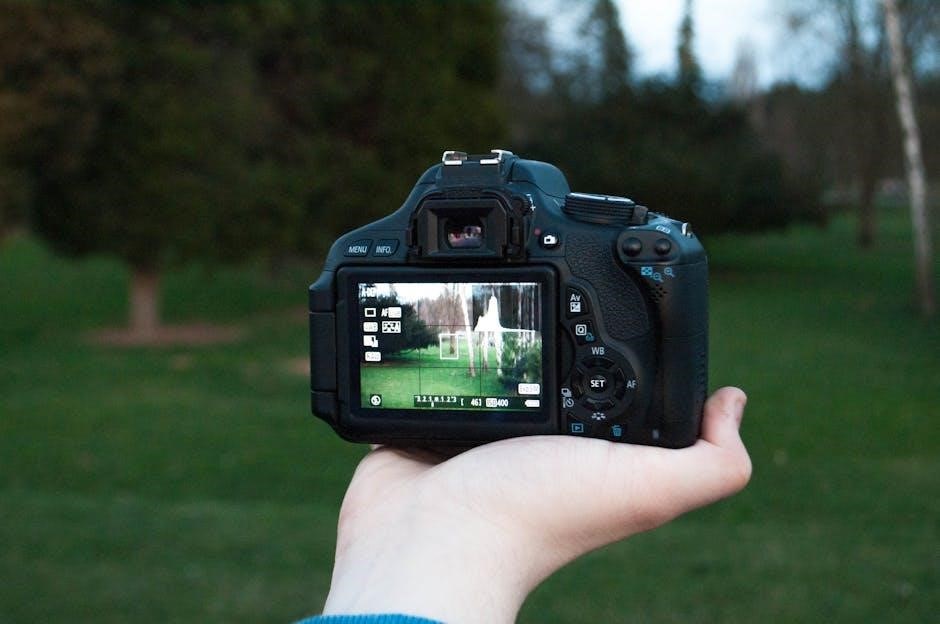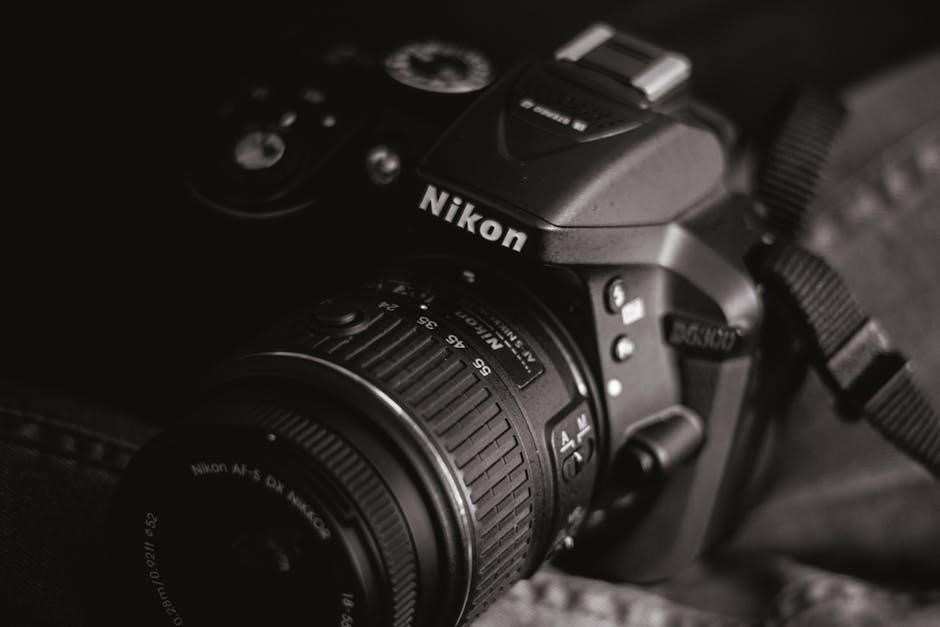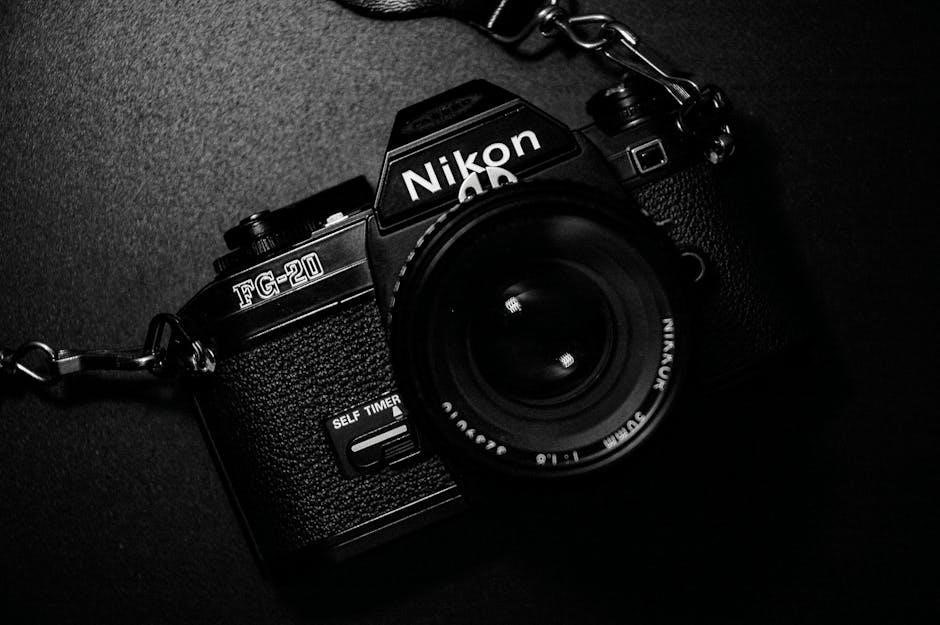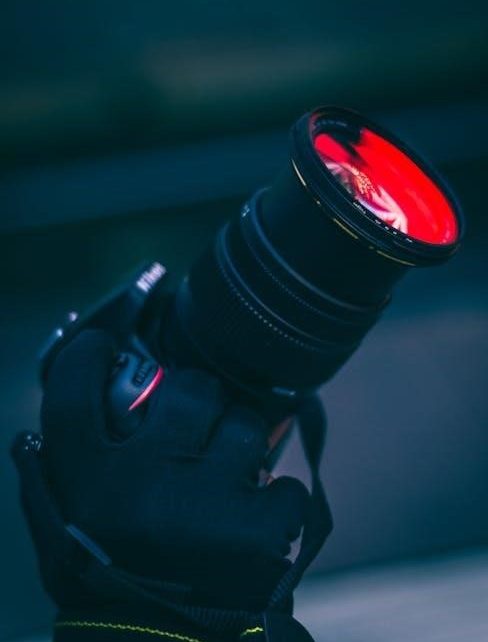Welcome to the Nikon F2 user manual, your comprehensive guide to mastering this iconic 35mm SLR camera. This manual covers everything from basic operations to advanced features, ensuring you unlock the full potential of your Nikon F2.
Overview of the Nikon F2 Camera
The Nikon F2 is a legendary 35mm single-lens reflex (SLR) camera renowned for its durability, precision, and versatility. Introduced in 1971, it became a favorite among professionals and enthusiasts alike. The camera features a robust mechanical design, interchangeable viewfinders, and compatibility with a wide range of Nikkor lenses. Its aperture priority and manual modes cater to both creative control and ease of use. The F2’s interchangeable Bright Photomic viewfinder and accurate focusing system enhance shooting precision. With shutter speeds ranging from 10 seconds to 1/2000th of a second, it offers exceptional flexibility for various lighting conditions. This iconic camera remains a testament to Nikon’s commitment to excellence in photography.
Importance of Reading the User Manual
Reading the Nikon F2 user manual is essential to fully understanding and utilizing the camera’s features. The manual provides detailed instructions on operating the camera, from loading film to adjusting settings. It explains how to use the interchangeable Bright Photomic viewfinder, set aperture and shutter speeds, and focus accurately. The manual also offers maintenance tips, such as cleaning and storing the camera properly. By studying the manual, users can master the F2’s capabilities, ensuring optimal performance and longevity. It serves as a valuable reference, helping photographers of all levels to achieve their creative vision and troubleshoot common issues effectively.

History and Development of the Nikon F2
The Nikon F2, released in the 1970s, is a legendary 35mm SLR camera renowned for its durability, reliability, and professional-grade features, setting the standard for photography excellence.
Key Features and Innovations
The Nikon F2, introduced in 1972, revolutionized photography with its interchangeable bright photomic viewfinder and robust brass body construction. It featured a wide range of shutter speeds (10 seconds to 1/2000th of a second) and supported Nikkor lenses, offering versatility for professionals. The camera’s manual override for aperture control and compatibility with various accessories enhanced its functionality. These innovations solidified the F2’s reputation as a reliable and adaptable tool for photographers, making it a cornerstone of Nikon’s legacy in the world of photography.
Design and Build Quality
The Nikon F2 is renowned for its exceptional design and build quality, featuring a durable brass body that ensures longevity and robust performance. Its mechanical controls are precision-engineered for smooth operation, offering photographers intuitive handling. The camera’s interchangeable photomic viewfinder system provides flexibility, while the ergonomic design enhances comfort during extended use. The F2’s construction reflects Nikon’s commitment to excellence, making it a reliable choice for professional photographers. Its timeless design and solid craftsmanship have cemented its status as a classic in the world of photography, ensuring it remains a trusted tool for capturing high-quality images;

Technical Specifications of the Nikon F2
The Nikon F2 is a 35mm SLR camera with a 24mm x 36mm format, featuring the Nikon F mount and shutter speeds from 10 seconds to 1/2000.
Camera Type and Picture Format
The Nikon F2 is a 35mm single-lens reflex (SLR) camera, designed for professional and enthusiast photographers. It features a 24mm x 36mm picture format, utilizing standard 35mm film rolls. This format ensures high-quality images with excellent detail and clarity. The camera supports interchangeable bright photomic viewfinders, enhancing versatility for various shooting needs. The F2 is compatible with a wide range of Nikkor lenses, making it adaptable for diverse photography styles. Its robust design and precise engineering make it a reliable choice for capturing stunning photographs. The 35mm film format allows for convenient processing and printing, aligning with industry standards for consistency and quality.
Lens Mount and Compatible Lenses
The Nikon F2 features the Nikon F mount, a bayonet-type lens mount compatible with a wide range of Nikkor lenses. This includes popular options like the Nikkor 50mm f/1.4, 55mm f/1.2, and other focal lengths. The F mount design ensures quick and secure lens changes, making it ideal for professional use. While the F2 does not support modern autofocus lenses, its compatibility with legacy Nikkor lenses offers versatility for photographers seeking classic optics. Adapters are also available for using newer lenses, enhancing its adaptability. The F mount’s durability and precision ensure optimal performance across various photography applications, making the Nikon F2 a versatile choice for both film enthusiasts and collectors.
Shutter Speed and Aperture Range
The Nikon F2 offers exceptional control over exposure with a wide range of shutter speeds and aperture settings. Shutter speeds range from 10 seconds to 1/2000 of a second, with a Bulb mode for extended exposures. The aperture range varies depending on the lens, typically from f/1.4 to f/16 or f/22 for precise light control. This flexibility allows photographers to achieve creative depth of field and motion effects. The camera’s manual operation ensures that users have full command over these settings, making it ideal for professionals and enthusiasts who value precise control. The F2’s mechanical design guarantees accurate and consistent exposure results.

Viewfinder and Focusing System
The Nikon F2 features an interchangeable Bright Photomic viewfinder, offering 100% frame accuracy and clear visibility of exposure data. Its interchangeable focusing screens enhance precision and versatility for various shooting needs.
Interchangeable Bright Photomic Viewfinder
The Nikon F2’s interchangeable Bright Photomic viewfinder provides unparalleled clarity and customization. Offering 100% frame coverage, it ensures accurate composition and visibility of essential exposure data. The viewfinder’s brightness and interchangeable focusing screens cater to various shooting styles, enhancing precision. This feature is particularly advantageous for professionals and enthusiasts seeking optimal control over their photography. Additionally, the ability to switch viewfinders allows for adaptability in different lighting conditions, making the Nikon F2 a versatile tool for diverse photographic scenarios.
Focusing Screen and Accuracy
The Nikon F2 features a Type A focusing screen, designed for precision and versatility. This interchangeable screen provides clear visibility, enabling accurate manual focusing. The focusing screen’s design minimizes eye strain, while its bright markings ensure sharp focus acquisition. With options like split-image and microprism screens available, photographers can tailor the F2 to their specific needs. The system’s accuracy is renowned, delivering consistent results for both professionals and enthusiasts. This attention to detail ensures that the Nikon F2 remains a reliable choice for achieving sharp, well-composed images, making it a timeless tool for photographers who value precision and control.
Exposure Data Visibility
The Nikon F2’s viewfinder provides clear exposure data visibility, essential for precise control over your photography. The bright, interchangeable Photomic viewfinder displays key exposure information, including shutter speed and aperture settings. LED indicators inform you of overexposure or underexposure, while a built-in shutter speed and aperture scale ensures you can quickly verify settings without removing your eye from the viewfinder. This intuitive design allows photographers to make swift, accurate adjustments, ensuring optimal exposures in various lighting conditions. The F2’s exposure data visibility is a testament to its practicality and user-centric engineering, making it a reliable tool for both professionals and enthusiasts alike.

Using the Nikon F2 Camera
Mastery begins with understanding the Nikon F2’s intuitive controls. Learn to load film, set aperture, adjust shutter speed, and focus precisely to capture exceptional images every time.
Loading Film
Loading film into the Nikon F2 is a straightforward process that requires care to ensure proper function. Open the camera back by pulling the film advance lever. Insert the film cartridge into the film chamber, attaching the leader to the take-up spool. Close the back and advance the film using the lever until it stops. Set the frame counter to “S” for 20 exposures or “M” for 36 exposures. Wind the shutter to prepare for the first shot. Always handle film in low-light conditions to prevent exposure. Practice loading without film to build confidence. This step is crucial for capturing sharp,well-exposed images with your Nikon F2.
Setting the Aperture
Setting the aperture on the Nikon F2 is done by rotating the aperture ring on the lens. Choose from a range of f-stops, such as f/1.4, f/2, f/2.8, and more, depending on your lens. The aperture controls the amount of light entering the camera and affects depth of field. To set the aperture, ensure the lens is in manual mode. Align the desired f-stop with the aperture index mark. Be aware that the aperture lock on some lenses prevents accidental changes. The aperture should be set before taking a shot, as it directly impacts exposure. Experiment with different apertures to achieve the desired creative effect in your photographs.
Setting the Shutter Speed
To set the shutter speed on the Nikon F2, use the shutter speed selector located on the top of the camera. Rotate the dial to choose speeds ranging from 1/2000 of a second to 10 seconds. Speeds from 1/2000 to 1 second are click-stopped for precise adjustments. For longer exposures, set the dial to the ‘B’ position and use a cable release to avoid camera shake. Always set the shutter speed before loading film to ensure proper exposure. Practice using different speeds to master control over motion and light capture. Refer to the manual for detailed instructions on optimizing shutter speed for various shooting conditions.
Focusing Techniques
The Nikon F2 features a precise focusing system designed for sharp and accurate image capture. Use the split-image prism in the center of the viewfinder to align objects horizontally or vertically for quick focus. The microprism ring surrounds the split image, aiding in focusing by creating a shimmering effect when the subject is out of focus. For low-light conditions, the bright Photomic viewfinder enhances visibility. To focus manually, rotate the lens focusing ring while observing the viewfinder. Ensure the subject falls within the focusing screen’s marked area for optimal sharpness. Practice focusing on stationary and moving subjects to master the technique.

Accessories for the Nikon F2
Expand your Nikon F2’s versatility with a range of accessories, including interchangeable viewfinders, motor drives, and a variety of Nikkor lenses to enhance your photography experience.
Compatible Nikkor Lenses
The Nikon F2 is compatible with a wide range of Nikkor lenses, offering versatility for diverse photography needs. Popular options include the Nikkor 50mm f/1.4, 55mm f/1.2, and 35mm f/2, each providing exceptional sharpness and clarity. Telephoto lenses like the 105mm f/2;5 and 180mm f/2.8 are ideal for capturing distant subjects, while wide-angle lenses such as the 28mm f/2 and 24mm f/2.8 are perfect for landscapes and interior shots. Specialized lenses, including macro and fisheye options, further expand creative possibilities. All Nikkor lenses are designed to ensure optimal performance and compatibility with the F2, delivering high-quality results for professional and enthusiast photographers alike. Genuine Nikkor lenses guarantee reliability and superior image quality.
Motor Drive and Other Attachments
The Nikon F2 supports various accessories to enhance functionality. The MD-1 Motor Drive enables continuous shooting at up to 5 frames per second, ideal for action photography. The MD-2 and MD-3 Motor Drives offer similar capabilities but cater to different user preferences. Additional attachments include the DS-12 Exposure Control Attachment for automatic aperture control and the AR-3 Soft Focus Filter for creative effects. These accessories expand the F2’s versatility, allowing photographers to adapt to diverse shooting scenarios. Always use genuine Nikon attachments to ensure compatibility and optimal performance, maintaining the camera’s renowned reliability and image quality.
Viewfinder Accessories
The Nikon F2 offers a range of viewfinder accessories to enhance usability and customization. The interchangeable Bright Photomic Viewfinder provides 100% frame accuracy and features an optional grid screen for precise composition. Additional accessories include the Action Finder, designed for fast-paced photography, and the Waist-Level Finder for low-angle shooting. The F2 also supports auxiliary focusing screens, such as the A2, B2, and K3 screens, each tailored for specific applications like macro, landscape, or portrait photography. These accessories ensure photographers can adapt the viewfinder to their shooting style, improving accuracy and creativity. Genuine Nikon viewfinder accessories maintain the camera’s legendary durability and optical excellence.

Maintenance and Care
Regularly clean the camera and lenses with a soft cloth and avoid harsh chemicals. Store in a dry, cool place to prevent moisture damage. Handle with care to maintain optical and mechanical precision. Refer to the manual for detailed cleaning and storage tips to ensure longevity and optimal performance.
Cleaning the Camera and Lenses
Regular cleaning is essential to maintain the Nikon F2’s performance and longevity. Use a soft, dry cloth to wipe the camera body and external surfaces, avoiding harsh chemicals. For the lenses, gently remove dust and smudges with a microfiber cloth or lens tissue. Avoid touching the lens surfaces, as oils from your skin can leave residue. For stubborn spots, lightly dampen the cloth with distilled water, but never apply liquid directly to the lens. Use a small, dry brush to clean the viewfinder and mirror box. Avoid using canned air, as it may push debris further into the camera. Clean regularly to prevent dust buildup and ensure optimal image quality.
Storage and Protection
Proper storage and protection are crucial to preserve your Nikon F2’s functionality and extend its lifespan. Store the camera in a cool, dry place, away from direct sunlight and extreme temperatures to prevent internal components from degrading. Use a protective case or pouch to shield the camera from dust and physical damage. Consider placing silica gel packets in the storage area to maintain a stable humidity level and prevent moisture-related issues. Avoid storing the camera with batteries to prevent corrosion. Regularly inspect the camera and accessories for signs of wear or damage, and address any issues promptly to maintain optimal performance.
Troubleshooting Common Issues
Troubleshooting common issues with your Nikon F2 ensures optimal performance and longevity. If the shutter fails to release, check if the film is properly loaded or if the shutter is accidentally locked. For inaccurate light meter readings, clean the exposure meter with a soft brush or replace the battery if it’s weak. Fogging on the lens or viewfinder can be resolved by storing the camera in a dry environment or using a desiccant. If focusing is inconsistent, inspect the focusing screen for damage or misalignment. Regularly cleaning the camera and lenses prevents dust buildup, which can interfere with functionality. Addressing these issues promptly helps maintain your Nikon F2’s reliability and image quality.

Original Nikon F2 Manual
The original Nikon F2 manual is available as a PDF, providing authentic operation guides. Download it from trusted sources like ManualsDir.com or Mike Butkus’s repository for free access today.

PDF Manual Availability
The Nikon F2 user manual is widely available in PDF format, offering convenient access to detailed instructions and specifications; Websites like ManualsDir.com and Mike Butkus’s repository provide free downloads of the original manual, ensuring photographers can easily reference operating guidelines, technical details, and maintenance tips. These PDFs are scanned versions of the authentic manuals, preserving the original content for historical and practical use. They are compatible with various devices, making it easy to study the camera’s features and troubleshooting steps anytime, anywhere. This resource is invaluable for both new and experienced users seeking to master the Nikon F2.
Downloading the Manual
Downloading the Nikon F2 user manual in PDF format is straightforward and convenient. The manual is available on websites like ManualsDir.com and Mike Butkus’s repository, offering free access to the original documentation. The PDF file, typically around 70 pages, is compatible with all devices, ensuring easy readability. Users can download the manual directly from these sources without registration or fees. This digital version preserves the original content, including technical specifications, operation guides, and maintenance tips. By downloading the manual, photographers can access detailed instructions anytime, making it an essential resource for mastering the Nikon F2 camera. This ensures uninterrupted learning and troubleshooting.
Key Sections of the Manual
The Nikon F2 user manual is divided into key sections designed to guide users through every aspect of the camera. It begins with an introduction to the camera’s features and operation, followed by technical specifications like shutter speed, aperture, and lens compatibility. Detailed instructions are provided for loading film, setting exposures, and focusing accurately. Maintenance tips, such as cleaning and storage, ensure longevity. Troubleshooting common issues and understanding the viewfinder system are also covered. The manual concludes with resources for further learning, making it an indispensable tool for both novice and experienced photographers. This structured approach ensures a comprehensive understanding of the Nikon F2.

Additional Resources and References
Explore online communities, forums, and dedicated websites like ManualsLib for Nikon F2 resources. Mike Butkus’s archive offers detailed PDF manuals, while forums provide user insights and troubleshooting tips.
Online Communities and Forums
Online communities and forums are invaluable resources for Nikon F2 enthusiasts, offering troubleshooting tips, user experiences, and detailed discussions. Websites like ManualsLib and Mike Butkus’ archive provide extensive libraries of Nikon F2 manuals and guides. Additionally, forums such as those dedicated to vintage cameras often feature threads where photographers share their insights and solutions for common issues. These platforms not only help users master the Nikon F2 but also foster a sense of community among photographers. By engaging with these resources, you can gain deeper knowledge and practical advice to enhance your photography experience with the Nikon F2.
Repair and Service Manuals
Repair and service manuals for the Nikon F2 are essential for photographers and technicians seeking detailed guidance on maintenance and repairs. These manuals, often available in PDF format, provide step-by-step instructions for disassembling, diagnosing, and repairing various components of the camera. They include schematics, parts lists, and troubleshooting tips, making them invaluable for resolving mechanical issues. Many online archives, such as those from Mike Butkus and other photography enthusiasts, offer free downloads of these manuals. Whether you’re addressing shutter issues, aperture malfunctions, or viewfinder problems, these resources ensure your Nikon F2 remains in optimal working condition, preserving its legacy as a reliable photographic tool.
Third-Party Guides and Tutorials
Third-party guides and tutorials for the Nikon F2 offer complementary resources beyond the official manual, providing hands-on tips and creative techniques. Websites like Mike Butkus’ collection and photography forums feature detailed PDF guides, focusing on practical advice for using the F2. These resources often include troubleshooting tips, maintenance routines, and insights from experienced photographers. Additionally, video tutorials and blog posts explore advanced techniques, such as optimizing exposure settings and mastering manual focus. Many enthusiasts also share their personal experiences, offering unique perspectives on getting the most out of the F2. These guides are invaluable for both beginners and seasoned photographers aiming to enhance their skills with this iconic camera.
Mastering the Nikon F2 requires careful study of its manual, offering period-specific insights and tips. This iconic camera’s legacy endures, inspiring photographers with its timeless design and functionality.
Final Tips for Mastering the Nikon F2
To fully master the Nikon F2, study its manual thoroughly and practice using its controls before loading film. Regularly clean and maintain the camera to ensure optimal performance. Experiment with different Nikkor lenses to explore various creative possibilities. Familiarize yourself with the interchangeable viewfinder and focusing screens for enhanced precision. Always carry the manual for quick reference, as it contains valuable insights for troubleshooting and camera care. By following these tips, you’ll unlock the full potential of your Nikon F2 and capture stunning images with this legendary camera.
The Legacy of the Nikon F2
The Nikon F2 is a landmark camera in photographic history, celebrated for its durability, reliability, and innovative design. Produced from 1972 to 1980, it became a favorite among professional photographers due to its robust build and precise mechanics. Its interchangeable viewfinder system and wide range of compatible lenses set a new standard for SLR cameras. The F2’s legacy endures as a symbol of Nikon’s commitment to excellence, influencing future camera designs. Today, it remains a cherished collectible and a testament to the golden era of film photography, continuing to inspire photographers and camera enthusiasts worldwide with its timeless appeal and functionality.


